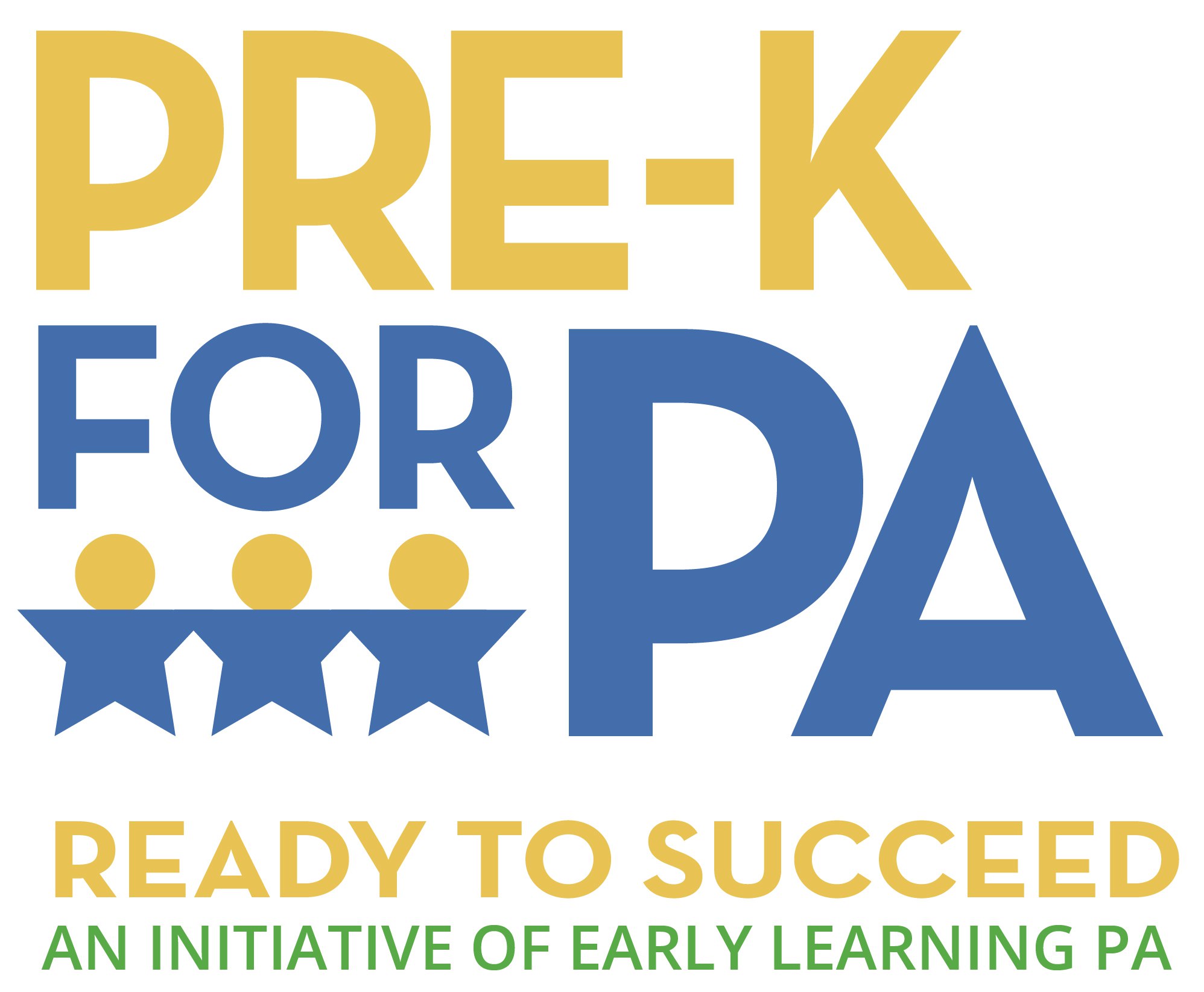
PennLive: In another tight state budget year, advocates make case for preschool funding
January 25, 2017 by Charlie Thompson
In a tight budget year, one group that still feels confident enough to ask for growth in state funding are advocates for expanded access to preschool programs.
Leaders of the Pre-K for PA coalition pressed their case at the Capitol Tuesday at a rally headlined by two native-son athletes, Penn State and Pittsburgh Steeler great Franco Harris and Olympic wrestler Bruce Baumgartner.
Pre-school initiatives received a $30 million boost from Gov. Tom Wolf and legislators in the 2016-17 budget, for a total of more than $190 million in the state’s Pre-K Counts and Head Start programs.
Including federal- and locally-funded programs, about 64,000 low- and moderate-income children are served through quality publicly-funded programming.
The coalition, however, estimates there are still nearly twice that many kids unserved. Advocates are pressing state officials to continue working to close that gap this year, asking for an increase of $85 million.
Wolf has consistently said this winter that he will look to continue his pattern of increasing state investment in education.
Read the article here.

CBS21: Franco Harris and Bruce Baumgartner talk about the importance of pre-k
January 25, 2017
HARRISBURG, Pa — Two standout athletes talked about the importance of academics in Harrisburg today.
Pittsburgh Steelers legend Franco Harris and four-time Olympic medalist Bruce Baumgartner called on lawmakers to scale up access to high quality pre-kindergarten programs.
I had what we called nursery school back when I was growing up and I could see that some of the kids had a little bit of an advantage over some of the kids who maybe didn’t have that opportunity.
They found that American children are far behind the pack when it comes to international academic achievements.
In creating more access to pre-K programs they hope kids will be better prepared for academic and lifetime success.
Watch the video here.

Times Leader: Report: No publicly funded pre-school for 70 percent of eligible students
December 15, 2016 by Mark Guydish
An online map released Wednesday allows anyone with a computer and internet connection to check preschool availability throughout Pennsylvania, and the news is grim locally.
According to data on the map, 70 percent of children ages 3 and 4 in Luzerne County school districts who are eligible for publicly funded preschool can’t get into a program for one simple reason: There aren’t nearly enough slots available.
The map, posted by the Pennsylvania Partnerships for Children at papartnerships.maps.arcgis.com, provides data for state Senate districts, state House districts, or school districts.
In each case, it shows the number of children ages 3 and 4, the number and percent of those who are economically eligible for “high quality, publicly funded pre-k,” and the percent of those eligible but “unserved. It also shows locations of pre-k services, both publicly funded and private.
Children are eligible if family income is at or below 300 percent of federal poverty level (or $72,900 for a family of four).
A persistent proponent of early childhood education, Pennsylvania Partnerships for Children repeatedly has pushed for increased state funding for programs. The map was released as part of “A Path Forward,” an effort to get Harrisburg lawmakers to increase pre-kindergarten spending by $85 million next year, providing service to another 10,000 children.
While the organization does not specify where the money would come from, it routinely cites studies saying such investments pay up to 17-fold in savings because children who get solid educational support early on are less likely to require more costly special education services later, end up in the justice system, or end up on welfare.
During a web-based presentation, Partnerships President Joan Benso said the ultimate goal is to “ensure that every child eligible for publicly funded pre-k gets the opportunity.”
Benso conceded there are problems with rapid expansion. Existing providers might need support in scaling up for a big surge in enrollment, and pay for employees generally has been flat for nearly a decade. “There has been no child care pay increase from the state since 2007 for most providers,” Benso said.
Partnerships has a suggested four-step “path forward,” with the first step being the most costly: Along with an increase of $85 million in state spending on pre-k next year, it calls for “growing the investment to an additional $340 million by 2020-21.
It calls for another $100 million by 2022-23 to begin serving children in families with incomes above the 300 percent-of-poverty threshold.
Read the full article here.

Lancaster Online: Study: Thousands of Lancaster County children eligible for free preschool aren’t getting it
December 15, 2016 by Heather Stauffer
Thousands of Lancaster County children eligible for publicly-funded preschool are not enrolled in any programs because of insufficient state funding and dearth of quality pre-K programs, a new study says.
The statewide study by the nonprofit Pennsylvania Partnerships for Children found that nearly 113,000 three- and four-year-olds across the state are eligible for publicly-funded preschool education but are missing out.
Quality pre-K education, the study said, can reduce grade repetition, special education placements, and dropout rates. Calling for greater state funding for preschool, researchers said that every $1 invested saves about $17 in the long run.
“The need is great everywhere,” said Joan Benso, CEO of the Harrisburg-based advocacy organization.
The partnership is asking Pennsylvania legislators for an additional $85 million for preschools in next year’s budget, rising to $340 million by 2020.
By contrast, this year’s budget raised preschool funding by $30 million.
In Columbia Borough School District, only 56 percent of preschoolers who qualified for high-quality publicly funded preschool received it, the report said.
In School District of Lancaster, it was only 45 percent.
In four districts — Donegal, Hempfield, Manheim Township and Ephrata — it was less than 40 percent.
And in the rest of the county’s 16 districts, it was less than 20 percent, with Elanco, where only 2 percent of eligible children received preschool education.
Local superintendents said they have been making efforts to reach children who can’t get into preschools, ranging from free videos containing educational tips to special workshops.
Brian Bliss, superintendent of Solanco School District, said it goes as far as mailing all families of three-year-olds a list of all preschool and daycare programs in the area each year.
“We have long desired to increase the number of students who access quality preschools in our area,” he said.
However, he noted the situation may be rosier than the report indicates, because the partnership counted only preschools that have gone through the state’s assessment process.
“We have a number of preschools that are excellent, but they have not gone through the steps required for the ‘high quality’ designation,” he said.
Bob Hollister, who’s serving as superintendent for both Columbia and Elanco districts this year, said this year Elanco is introducing six-week pre-K sessions at each of its elementary schools.
“It’s difficult to argue against pre-K preparation,” he said.
Andrea Heberlein is lead director of community impact for United Way of Lancaster County, which has made school readiness one of its four big goals for this decade.
“It is critical for the well-being of our children, and the entire community, to rally behind the efforts to provide quality pre-K education and ensure that by 2025 all children in Lancaster County will enter kindergarten ready to learn,” she said.
Read the article here.

York Daily Record: Most needy kids in York County aren’t getting pre-k
December 15, 2016 by Angie Mason
When children arrive for kindergarten, they come with a wide range of abilities. Some of them might know the alphabet, nearly able to read. Others might recognize only a few letters.
“It makes it challenging,” said South Western School District Supt. Barbara Rupp. “We work hard to lessen that gap.”
South Western has been meeting with area preschools for a few years to address that need, Rupp said. District educators explain what’s expected of kindergarten students and share training to help the providers better prepare kids.
South Western also changed its kindergarten registration process to help identify early those children who might need more help. The district makes home visits over the summer and takes families books. The district and its foundation also pay for a program that will deliver daily early-childhood activities to a parent’s phone or email.
A state advocacy group says there’s another way to help get those kids started right: Put more state money toward publicly funded, high quality pre-kindergarten programs.
Pennsylvania Partnerships for Children released a report this week looking at how many 3- and 4-year-old children who were eligible for such programs were actually enrolled in them. Statewide, the report showed 64 percent of eligible children — those who are low-income or have other special needs — did not have access to programs, and there are gaps everywhere — in rural, suburban and urban areas.
In eight school districts in York County, less than 10 percent of the 3- and 4-year olds who are eligible are actually enrolled in a program. In the South Western and Spring Grove districts, the report showed none of the eligible children were being served.
The report says high quality programs include Pre-K Counts, Head Start, school district programs and child care centers that have earned the higher spots on the Keystone Stars quality ranking system. An online map with the report shows that in many areas of York County there are few or no such programs available.
Good Shepherd Child Care in Glen Rock, which has the highest Keystone Stars rating of 4, is the only program in the Southern York County School District boundaries, according to the report. In order to earn the higher Stars rating, a certain percentage of students must be funded by public subsidies, and there are additional requirements to meet, like more education for staff.
It’s a lot more work, said director Pamela Prowell.
“But child outcomes, you can see the difference,” she said. “You’ve got kids that come to you from strong, healthy, functioning families. Then you’ve got kids that come from families that aren’t functioning, aren’t strong. That makes our jobs that much more important so when they get to public school, they’re ready.”
Shirl Quinan, who owns the Kidsville Junction centers in Stewartstown and Fawn Grove, said she thinks there are also parents who don’t want to apply for child care funding because they think it’s a handout. Her centers have 3-star ratings, and it can be costly and difficult to maintain that. At least 10 percent of the centers’ children must be funded by subsidies.
“I feel, in the bottom of my heart, it’s the right thing to do,” she said.
The York City School District has the most children eligible for free programs, nearly twice as many as Red Lion, which has the next largest population. But more children in the city, 69 percent, are being reached than in any other district.
The school district offers free pre-k in all of its buildings, some funded through Pre-K Counts and some paid for out of the district’s budget. The district has been working to expand the programs in recent years, aiming to one day reach all city children.
Other organizations in the city offer programs, too, like the YWCA York, which has Pre-K Counts and a 4-Star rated child care program. Ruby Martin, the YWCA’s chief program officer, cautioned that there is still a huge need in the city, even though things might look good on paper.
At the YWCA alone, “we have 50 kids on a waiting list for pre-k,” Martin said. “It’s a pretty significant need if we want to get kids the start that they need.”
What’s the solution?
Pennsylvania Partnerships for Children says there’s a need for more state investment in early childhood programs, specifically: $85 million more in 2017-18, and $340 million more by 2020-21 to serve all eligible children.
Read the full article here.

York Dispatch: New tool maps local pre-K data
December 14, 2016 by Alyssa Pressler
A report and a new online mapping tool from Pennsylvania Partnerships for Children highlights the publicly funded pre-K education opportunities, and lack thereof, in local areas.
The report and mapping tool, both titled “A Path Forward,” were released Wednesday to the public. The report, which can be found on the organization’s website, says 112,900 eligible preschool-age children statewide are not served by publicly funded pre-K opportunities.
This data states 68.4 percent of students in rural school districts have an unmet pre-K need, 51.2 percent of students in urban school districts have an unmet need and 74.2 percent of students in suburban school districts have an unmet need.
According to the report, all data was provided by the PA Kids Count Data Center, which is a project of the Annie E. Casey Foundation that tracks a number of data sets to follow the “well-being” of children in the United States, according to its website.
With the report came the release of an online mapping tool for the state in which users are able to see specific data on pre-K in their school district. Information they can view includes the number of children ages 3 to 4, eligible children for publicly funded pre-K, the percentage of students enrolled in publicly funded pre-K, the percent of students unserved, the number of high-quality pre-K locations and the number of additional pre-K classes that would be needed to serve the entire eligible population.
Past reporting by The York Dispatch has revealed that 84 percent of York County 3- and 4-year-old children do not have access to high-quality pre-K. Families in need are hit the hardest when it comes to access: nearly 60 percent of children without access to high-quality pre-K education are in families with incomes below 300 percent of the poverty line.
York City School District has the lowest population of children not served by publicly funded pre-K, because pre-K classrooms are in each K-8 building in the district. Each of the seven K-8 buildings has at least one pre-K classroom, and many offer several. The district has stated its goal is to have a pre-K spot available in its program for every 4-year-old in the city.
Spring Grove Area School District and South Western School District have the highest rate of children not being served by publicly funded pre-K programs, both at 100 percent, because of the lack of publicly funded pre-K programs in those districts either through the public school or through organizations such as Head Start of York County.
Below, in descending order, are the rates of students not served by high-quality, publicly funded pre-K education in each of York County’s school districts.
South Western School District: 100 percent
Spring Grove Area School District: 100 percent
Red Lion Area School District: 97.2 percent
Dover Area School District: 96.1 percent
Dallastown Area School District: 95.1 percent
West Shore School District: 94 percent
Eastern York School District: 91.8 percent
Southern York County School District: 91.5 percent
Northern York County School District: 90.9 percent
West York Area School District: 89.1 percent
Central York School District: 85.4 percent
Northeastern York School District: 70.6 percent
Hanover Public School District: 70.1 percent
South Eastern School District: 68 percent
York Suburban School District: 67.4 percent
York City School District: 30.9 percent
Read the article here.





